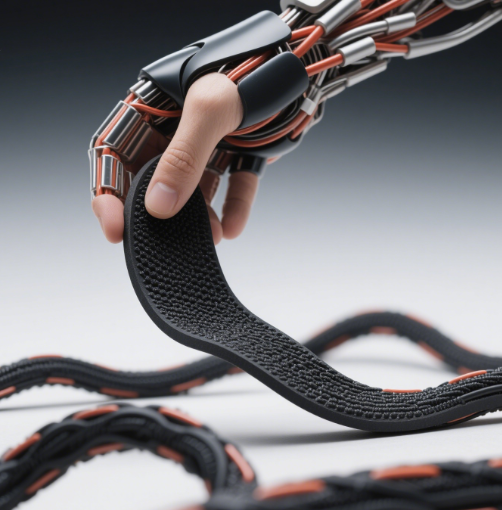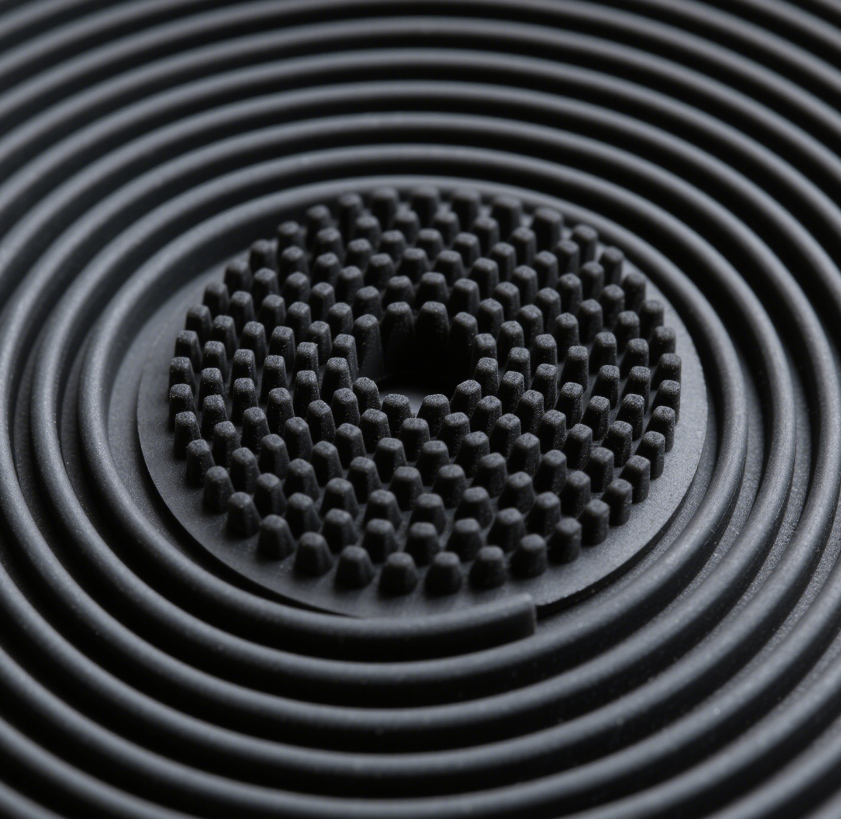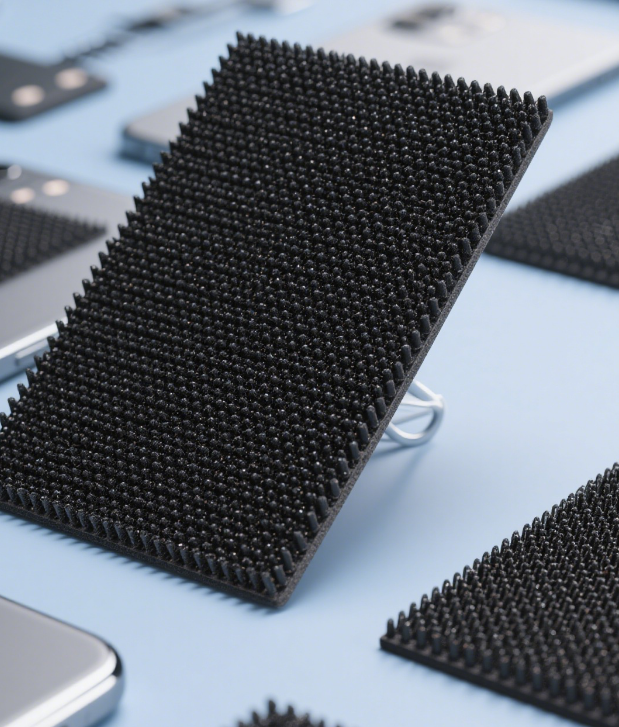Conductive Rubber of Bionic Materials
 Conductive Rubber of Bionic MaterialsThe conductive rubber of bionic materials is a new type of intelligent material developed by imitating biological structures or functions and combining the characteristics of conductive rubber. Its core lies in combining the high efficiency and adaptability of biological systems with the conductivity and flexibility of conductive rubber, which is widely applied in fields such as flexible electronics, medical health, aerospace, etc. The following analysis is carried out from aspects such as technical principles, application scenarios, research progress and future trends:
Conductive Rubber of Bionic MaterialsThe conductive rubber of bionic materials is a new type of intelligent material developed by imitating biological structures or functions and combining the characteristics of conductive rubber. Its core lies in combining the high efficiency and adaptability of biological systems with the conductivity and flexibility of conductive rubber, which is widely applied in fields such as flexible electronics, medical health, aerospace, etc. The following analysis is carried out from aspects such as technical principles, application scenarios, research progress and future trends:
- Technical Principles and Bionic Design
Biologically Inspired Structural Design - Multilayer Network Structure: Hydrogenated acrylonitrile-butadiene rubber (HAE-T) has been developed. The mechanical strength is increased by 100 times and the cross-linking density is increased by 1444 times through covalent and non-covalent cross-linking. On this basis, carbon nanotubes (CNT) are introduced to construct a continuous conductive network, and the HAEC7-T conductive rubber is prepared, which is used in the triboelectric nanogenerator (TENG) and still maintains stable triboelectric output performance in harsh environments.
- Self-isolation Network Structure: Through the charge interaction between poly(3,4-ethylenedioxythiophene)-polystyrene sulfonate (PEDOT:PSS) and the latex solution, the X technology patent forms a bionic self-isolation network, and a stretchable (tensile ratio of 340%) and conformally fitting composite film is prepared, which is used in non-contact humidity, temperature and somatosensory sensors, with a detection distance of up to 12 cm.
- Shrinkage Conductive Rubber Electrode: The bionic electronic skin realizes synchronous detection of strain (0-300%), pressure and temperature through the layer-by-layer self-assembly of the shrunk reduced graphene oxide/multi-walled carbon nanotubes (RGO/MWCNTs) film, with a sensitivity reaching – 1.35%/% RH (humidity) and – 0.72%/℃ (temperature).
- Conductive Mechanism and Material Innovation
- Filler Optimization: Traditional conductive rubber relies on metal particles (such as silver-plated copper, aluminum), but there are problems of oxidation and high density. In bionic design, nanoscale fillers such as carbon nanotubes and graphene are widely used.
- Dynamic Cross-linking Network: Through the self-assembly of conductive fillers induced by cellulose nanocrystals (CNC), combined with supramolecular structures such as dynamic ionic bonds and coordination bonds, real-time (≤30 seconds) and multiple self-healing (repair efficiency of 93%) at room temperature are realized, which is used in wearable sensors.
- Core Application Fields
Flexible Electronics and Wearable Devices - Electronic Skin: It imitates the tactile and temperature perception capabilities of human skin and is used for medical health monitoring (such as wound healing, heart rate detection) and human-computer interaction.
- Flexible Sensors: They are used for the detection of pressure, strain and chemical solvents.
Aerospace and Military
- Electromagnetic Shielding and Vibration Damping: The heat-conductive and conductive rubber shock absorber solves the problem that traditional rubber cannot conduct heat and electricity, and is used for the heat dissipation and anti-vibration of airborne equipment.
- Self-healing Materials: By imitating the self-healing mechanism of organisms, conductive rubber that can repair cracks is developed to improve the reliability of aircraft in harsh environments.
Medical and Biological Engineering
- Nerve Repair: The ultra-soft conductive PDMS elastomer (Young’s modulus < 11 kPa) is used for spinal cord injury repair, which can conduct optical signals and is compatible with biological tissues.
- Intelligent Dressings: The artificial electronic skin combined with tissue regeneration materials can monitor the wound healing process in real time and promote the growth of dermal tissues.
III. Research Progress and Commercialization
Breakthroughs in Frontier Research
- Highly Stable Materials: The HAE-T rubber shows excellent stability in environments such as ultraviolet, ozone, acid and alkali, and its mechanical strength reaches the leading level in the industry.
- Self-healing Technology: The real-time self-healing sensor can monitor tiny physiological activities, and the efficiency still reaches 93% after 3 repairs.
- Ultra-soft Electronic Devices: The SWCNT/PDMS composite material achieves an ultra-low modulus (<11 kPa) and high conductivity (>2 S/m), which is suitable for wearable devices.
- Commercialization Cases
- Enterprise Products: Electromagnetic shielding conductive rubber is used in aerospace and electronic equipment.
- Market Growth: The global conductive silicone rubber market is expected to grow at a compound annual growth rate of 8% from 2023 to 2030, and the demand in the electronics and automotive fields is significantly driving.
- Challenges and Future Trends
Technical Bottlenecks - Long-term Stability: The oxidation of conductive fillers and insufficient interface bonding may lead to performance degradation, and antioxidant coatings or dynamic cross-linking networks need to be developed.
- Cost and Scalability: The cost of nanoscale fillers (such as CNT, MXene) is relatively high, and the preparation process needs to be optimized to achieve mass production.
- Environmental Adaptability: The performance fluctuations under extreme temperature and humidity still need further research. The shielding effectiveness of HAEC7-T reaches 120 dB at 10 GHz, but the data on high-temperature stability are limited.
Future Directions
- Intelligence and Multifunctionality: Integrate functions such as self-healing, temperature response, and biocompatibility, for example, self-healing conductive rubber is used in intelligent robots.
- Deepening of Bionic Structures: Imitate the conductive networks of biological nerves and blood vessels to improve the dynamic response ability of materials.
- Green Manufacturing: Develop bio-based fillers (such as natural rubber, cellulose) and environmentally friendly processes to reduce the dependence on petrochemical resources.
- Comparison of Typical Performance Parameters
Material Type Conductivity (S/m) Tensile Strength (MPa) Operating Temperature Range (℃) Self-healing Efficiency Application Scenarios
Traditional Conductive Rubber 0.01-100 5-15 -65~200 None Electromagnetic Shielding, Electronic Buttons
HAE 100-500 50-100 -65~125 None Triboelectric Nanogenerator
Bionic Self-healing Rubber 1-100 2-5 -40~80 93% (3 times) Wearable Sensors
Ultra-soft Conductive PDMS 2-5 0.1-0.5 -50~100 None Spinal Cord Repair, Ultra-soft Electronic Devices
Conclusion
The conductive rubber of bionic materials shows great potential in fields such as flexible electronics, medical health, and aerospace by imitating biological structures and functions. Although facing challenges such as stability and cost, its trends of intelligence and multifunctionality will promote technological breakthroughs. In the future, with the deep integration of materials science and bionics, this type of material is expected to achieve commercial applications in a wider range of scenarios and provide key support for the next generation of intelligent devices.
















